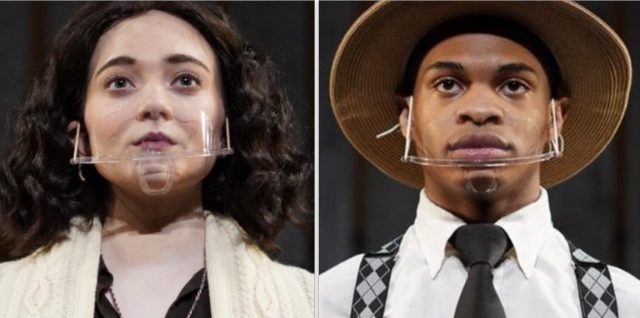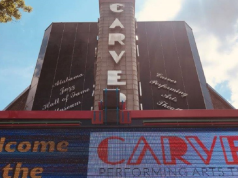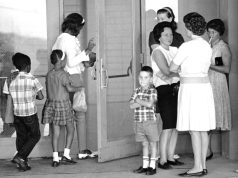By Richard Friedman
For The Birmingham Times
It was a trip Cameron Mayers had to make, driving 90 miles and 65 years back into history.
Mayers, an 18-year-old Mississippi State University freshman, would play Emmett Till in a Nov. 10-13 campus production of “Anne and Emmett.”
The play imagines a conversation in the afterlife between Till, an African-American teen brutally murdered by white racists in 1955, and Anne Frank, a Jewish teen who died in the Holocaust.
The one-act play, which debuted in 2009, was written by Janet Langhart Cohen, a TV journalist and author. She is married to former US Senator and Secretary of Defense William Cohen. She is African-American, Cohen has Jewish roots on his father’s side.
Till was murdered in Mississippi. The MSU play, done in tandem with a production at Hattiesburg’s William Carey University, marks what is believed to be the first time “Anne and Emmett” has been produced in the state.
This significance was not lost on Mayers, an impressive young man who grew up in Pearl, Mississippi who was headed for Yale until family illness kept him closer to home. Aside from his satisfaction over winning the part, he was moved by the chance to play Emmett Till.
Mayers was well-aware of the Till saga, having grown up in Mississippi. “I don’t think there was a time in my life that I didn’t know Emmett’s story. It was ingrained in my memory.”
This is not true of every young Mississippian. “One of the things I learned through this process is that a lot of people my age don’t know the story of Emmett Till,” said Mayers. “The story needs to be told. It’s a dark moment but it’s a moment that led to the Civil Rights movement and to where we are as a nation today.”
The MSU actor was familiar with Anne Frank’s story. As a youngster he visited a Holocaust education center in Houston, Texas with his uncle. Anne Frank and her famed diary were featured. “My uncle didn’t sugarcoat anything. He told me her story, what she went through, what the Jewish people went through.”
Till’s Place in Civil Rights
Mayers embraced his role with professionalism and passion. He immersed himself in the part, making the 90-minute drive from the MSU campus in Starkville to Money, a dot on the Mississippi map. Money, which likely would have remained under the radar like many small towns, is widely known among Civil Rights historians and others who know the Till story.
The Till murder and its aftermath played a major role in igniting the Civil Rights movement. Some historians believe it was the catalyst that started this dramatic wave of change.
Till, from Chicago, was visiting family in the Money area. There are conflicting reports about what happened. However, all accounts acknowledge that somehow the 14-year-old boy offended a white woman working in a country store.
This triggered racist rage in her husband and his half-brother who kidnapped and murdered Till and dumped his body in a river. “I wanted to dig more into the character, that’s why I went to the sites,” explained Mayers.
He not only dug into the character, he dug into himself. “Being in the actual space where he was murdered, the tin shed where the climax of Emmett’s life occurred, was an experience I will never forget. It opened my eyes, not just as an actor but as a human being.”
Watching a recent performance online, one could tell how moved all the actors were and how vested they were emotionally. Mayers, an African-American teenager himself, said that as the play unfolds he forgets who he is and becomes Emmett Till.
The stage setting was understated and stark. The dialogue was simple; mainly because this imagined tale tells itself. It is that powerful. It needs no embellishment.
Anne and Emmett meet in a place called “Memory.” Like many teens, they are standoffish at first. It is their shared experience that draws them to each other as they peel and probe their traumatic pasts. The actors become the characters; you forget the characters are actors.
Forced To Reflect
The show is painful. The dialogue is penetrating. Yet it is never desperate. From the start you sense the play is moving toward a redemptive conclusion. This is because the play forces you to reflect and ponder. And, after taking a deep breath, to resolve never to stand by idly when hatred begins to rear its violent head.
Particularly powerful was MSU student actor Allyn Hackman’s portrayal of Anne Frank. Hackman, a 21-year-old theatre major from Madison, Mississippi, did a masterful job of capturing Anne’s European accent and demeanor. She looked like Anne with her dark hair and dark eyes.
Playwright Langhart, in a post-performance chat with the cast, spotlighted Hackman for her outstanding performance, especially her reflection of the nuances in Frank’s character.
Anne Frank and the Holocaust have been an important part of Hackman’s life since seventh grade, when she first encountered Frank’s famous diary.
Since then, Hackman has committed herself to studying the Holocaust; thinking about it constantly, reading and watching everything she can, and visiting key European sites, including the Dachau concentration camp with her father.
“Walking into the concentration camp was absolutely horrifying,” said Hackman. She was 15 at the time, the same age as Anne. “Playing Anne Frank has been an honor.”
As a white Christian, Hackman has grown up with “privilege,” she said, free from persecution and being disadvantaged by her faith or skin color.
Playing Anne Frank reminded her that this is not the way it is for everybody and also that life is fragile; freedom, security, happiness and serenity are not a given and can evaporate quickly if hate-driven people ascend to power.
Hackman, engaging and inspirational, sees theatre as a way to change the world. “I believe the audience is the world — and having people watch you perform is a way to bring new ideas to life. What I especially want to do is encourage audiences to embrace and promote diversity, such as the musical ‘Hamilton’ has done so brilliantly.”
This young Mississippian believes that theatre should be a tool for getting people to think about things they haven’t thought about and pushing them beyond their comfort zone. Clearly, these beliefs shaped her portrayal of Anne Frank.
A driving force behind selecting and producing the play and helping students such as Mayers and Hackman change the world, was Tonya Hays, assistant professor of theatre performance at MSU.
She and faculty colleagues Matt Webb, who designed the set and lighting, and Melanie Harris, who costumed the play, convened a Zoom call last summer with the student theatre community regarding productions for the coming year.
The conversation took place amid the racial turmoil that was consuming the country. Students felt an urgency. They wanted to assert their voices — and educate about hatred.
This led Hays to “Anne and Emmett,” a perfect choice. “The play helps students address the complicated history of Mississippi, Civil Rights and racial injustice,” she noted.
Hays, though Catholic, also had a soft spot in her heart for scripts with a Jewish dimension. This stemmed from directing “Fiddler on the Roof” in a previous job in Gulfport. Through that experience, she and the all-Christian cast bonded with a local synagogue. In addition to a cross, she wears a Jewish star around her neck.
Repairing A Broken World
So a play linking Emmett Till and Anne Frank definitely caught this theatre professor’s attention and ignited her passion. Even watching it online, you could feel her pride and sense of purpose coursing through the show, along with her evident determination to help her students make the impact they wanted.
She succeeded.
Students who worked on the play adopted the mantra “Tikkun Olam.” This Hebrew phrase and Jewish imperative affirms that one’s sacred duty is to help repair our broken world. The students have claimed it as their own; Tikkun Olam has become their rallying cry.
Hays, talking about the play the day before it debuted, said, “Emmett and Anne don’t just tell their stories. They challenge the audience to go out and make a difference. That is the beauty of the play.”
Richard Friedman is associate editor of Southern Jewish Life magazine where this story first appeared.





